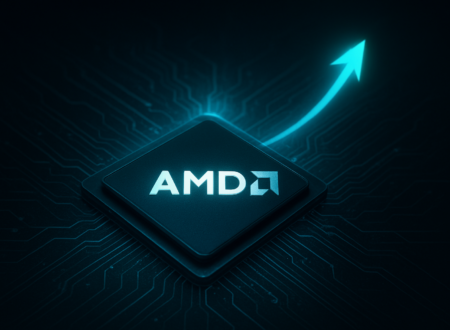NVIDIA’s AI Conquest Chipmaker Smashes Records as Blackwell Demand Fuels Global Expansion
NVIDIA Corporation has once again exceeded Wall Street expectations, delivering a blockbuster performance in its fiscal third quarter that reinforces its central, indispensable role in the global artificial intelligence revolution. The chip giant reported record breaking revenue and profit, driven almost entirely by explosive demand for its data center products, particularly the latest Blackwell architecture chips.
The results, released after the market close on November 19, 2025, provided a powerful counterargument to lingering concerns about an AI spending bubble. Chief Executive Officer Jensen Huang characterized the current environment in sweeping terms, stating simply that “AI is going everywhere, doing everything, all at once.” This outlook signals that the technology is rapidly moving beyond initial large scale model training into widespread commercial application across every industry.
Financial Powerhouse Data Center Dominance
NVIDIA’s third quarter performance was characterized by immense growth and efficiency.
The company reported total revenue of $57.0 billion for the quarter ended October 26, 2025. This figure represents a massive 62 percent increase compared to the same period last year, and it comfortably surpassed the expectations of analysts, who had generally forecasted revenue around $55.0 billion.
The undisputed core of this financial strength is the Data Center segment, which has fundamentally transformed NVIDIA’s business profile from a graphics card maker to the world’s leading AI infrastructure provider.
Data Center Revenue: The segment posted a record $51.2 billion in revenue, marking a 66 percent jump year over year. This figure alone would constitute a record quarter for many large technology companies.
Net Income and Earnings: Net income for the quarter soared to $31.91 billion, a 65 percent year over year increase. Adjusted earnings per share came in at $1.30, also topping analyst forecasts.
Profit Margins: The company demonstrated exceptional profitability at scale, with non-GAAP gross margins reaching 73.6 percent.
This remarkable financial performance underscores the fact that global investment in AI infrastructure is not just sustainable; it is actively accelerating.
The Blackwell Surge Supply Cannot Meet Demand
The sheer scale of the Data Center growth is directly attributed to the overwhelming demand for NVIDIA’s latest generation of AI accelerators, known as the Blackwell platform.
The Blackwell architecture, and specifically the flagship GB200 and GB300 components, have quickly become the most sought after products in the technology world. Chief Financial Officer Colette Kress confirmed that the Blackwell Ultra chip is now the company’s best selling product line across all customer categories.
CEO Jensen Huang’s statement on the earnings call captured the unprecedented market frenzy: “Blackwell sales are off the charts, and cloud GPUs are sold out.”
This shortage indicates a rare market scenario where the speed of demand continues to outstrip NVIDIA’s aggressive ramp up of production. The key drivers for this demand are:
Hyperscale Cloud Providers: Companies like Google Cloud, Microsoft, and Oracle are building massive AI infrastructure, known as AI factories, requiring hundreds of thousands of GPUs to power their large language models and offer advanced cloud services.
Enterprise Adoption: Businesses across sectors, from financial services to manufacturing, are rushing to integrate AI into their operations to boost productivity and efficiency, creating a huge new class of enterprise buyers.
Sovereign AI: Governments and sovereign nations are making strategic investments to build their own national AI infrastructure to ensure data security and technological independence, using NVIDIA systems as the foundation.
Furthermore, networking revenue, which encompasses the high speed links and systems that connect thousands of GPUs into functional AI supercomputers, reached a record $8.2 billion, showcasing the strategic importance of NVIDIA’s full system solutions. The integration of its compute and networking portfolios creates a powerful, high barrier to entry ecosystem for competitors.
The Virtuous Cycle AI Is Going Everywhere
Jensen Huang’s broad assessment that “AI is going everywhere, doing everything, all at once” is more than a slogan; it is a forecast for a new economic reality.
Huang elaborated that compute demand is now accelerating and compounding across both training (teaching AI models) and inference (running AI models in real time), with both functions growing exponentially. This signifies that the AI ecosystem has entered a virtuous cycle:
The creation of new and more powerful foundational models (training) drives greater demand for AI applications (inference).
Greater application deployment requires faster, more efficient chips and systems (more hardware demand).
The profits and scale generated from this hardware spending then fund the next generation of even more powerful AI models (more training).
This self reinforcing dynamic is what makes the current growth trend feel unstoppable.
Global Ecosystem Expansion
The company’s growth is fueled by a rapidly scaling AI ecosystem that includes:
New Foundation Model Makers: A wave of new companies and research groups are building large scale AI models, all of which rely on NVIDIA’s platform.
AI Startups: Thousands of startups are emerging across every sector, utilizing AI to solve specific industry problems.
Industry Diversification: The demand is no longer confined to the tech sector but is spreading to automotive, healthcare, finance, and manufacturing.
Geographic Reach: The expansion is happening in more countries, including strategic investments in markets like the United Kingdom and South Korea to build their next generation AI infrastructure.
NVIDIA also announced several high profile collaborations, including a strategic partnership with OpenAI to deploy substantial amounts of its systems for the AI company’s next generation infrastructure. It also partnered with industry leaders like Google Cloud, Microsoft, Oracle, and xAI to build the necessary AI compute capacity.
Easing AI Bubble Fears
The scale of NVIDIA’s performance came at a critical time for the broader market. In the weeks leading up to the earnings report, some investors had expressed growing skepticism, questioning whether the soaring valuations of AI related companies were justified and whether an AI bubble was beginning to form. This caution had caused a slight dip in the company’s stock value from its all time highs.
NVIDIA’s results, especially its robust forward guidance, served as a powerful antidote to this skepticism. The company is projecting fourth quarter revenue of $65 billion, far exceeding Wall Street’s expectation of around $62 billion. This optimistic forecast, built on a growing backlog of orders for Blackwell chips, convinced many investors that the spending surge is not speculative hype but a deep, long term structural investment.
Analysts quickly noted that the “fears of an AI Bubble are way overstated,” arguing that the spending is real, measurable, and driven by the world’s most profitable companies reinvesting billions of dollars into necessary infrastructure.
The sheer velocity of the company’s growth—with sales projected to be nearly ten times higher than the same period just three years prior—signals that the world is in the midst of the most significant technology infrastructure upgrade cycle in its history. NVIDIA’s powerful ecosystem, anchored by its CUDA software platform and its system level integrations, creates high barriers to entry, high switching costs for customers, and ensures its continued leadership in this accelerating transformation. The question is no longer about sustainable demand, but whether the supply chain can keep pace.





